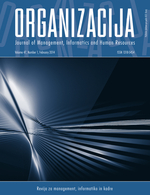Relationship between Selection, Optimization and Compensation and the Work Ability of Nurses over Fifty Years of Age
Abstract
Background and purpose: The raising of the retirement age in the field of nursing care increases the need for successful aging strategies in the work environment. The purpose of this paper is to analyse the application of selection, optimization and compensation and their correlation with the working ability of nurses aged fifty and over in Slovenia.
Design/Methodology/Approach: The study encompasses 433 nurses over the age of 50 (M = 53.75±2.40 years) working in 13 hospitals across Slovenia. Two measurement instruments used in the field of nursing were adapted, the model of Selection, Optimization and Compensation (SOC) and the Work Ability Index (WAI). Data was processed using descriptive statistical methodology. The correlation between statistical variables was calculated using Spearman’s correlation coefficients. For a description of the functional relationship between SOC use and calendar age, linear and potential regression functions were used.
Results: We found out that the use of SOC is slightly growing with the calendar age of the nurses. The most used SOC element is “selection”. Calculated WAI for nurses is at the lower end of the classification category “good” (M = 36.98±6.46) There is a positive correlation between SOC and WAI (rs = 0.23), causality was not studied.
Conclusions: Increased use of SOC can lead to better work ability by nurses over fifty. Therefore, in the future, nurses will need to be trained and motivated to use SOC strategies.
Keywords: Nursing; work ability index; selection, optimization and compensation; successful aging.
Design/Methodology/Approach: The study encompasses 433 nurses over the age of 50 (M = 53.75±2.40 years) working in 13 hospitals across Slovenia. Two measurement instruments used in the field of nursing were adapted, the model of Selection, Optimization and Compensation (SOC) and the Work Ability Index (WAI). Data was processed using descriptive statistical methodology. The correlation between statistical variables was calculated using Spearman’s correlation coefficients. For a description of the functional relationship between SOC use and calendar age, linear and potential regression functions were used.
Results: We found out that the use of SOC is slightly growing with the calendar age of the nurses. The most used SOC element is “selection”. Calculated WAI for nurses is at the lower end of the classification category “good” (M = 36.98±6.46) There is a positive correlation between SOC and WAI (rs = 0.23), causality was not studied.
Conclusions: Increased use of SOC can lead to better work ability by nurses over fifty. Therefore, in the future, nurses will need to be trained and motivated to use SOC strategies.
Keywords: Nursing; work ability index; selection, optimization and compensation; successful aging.
Refbacks
- There are currently no refbacks.

